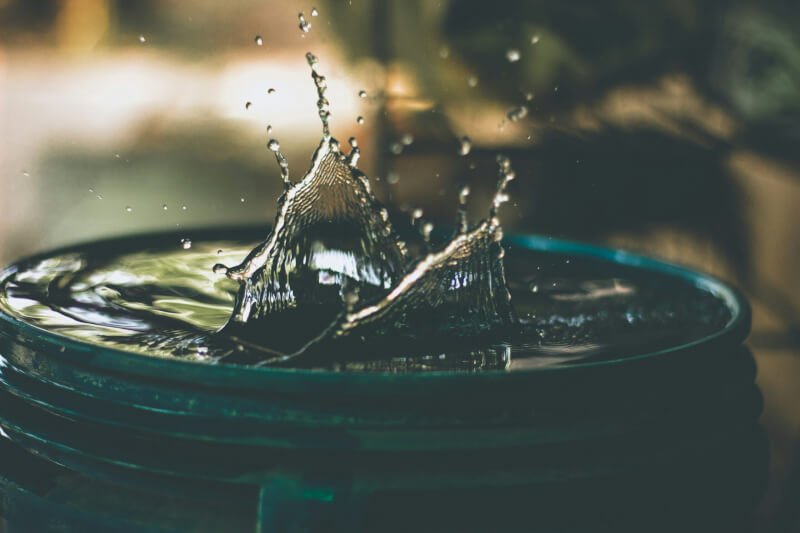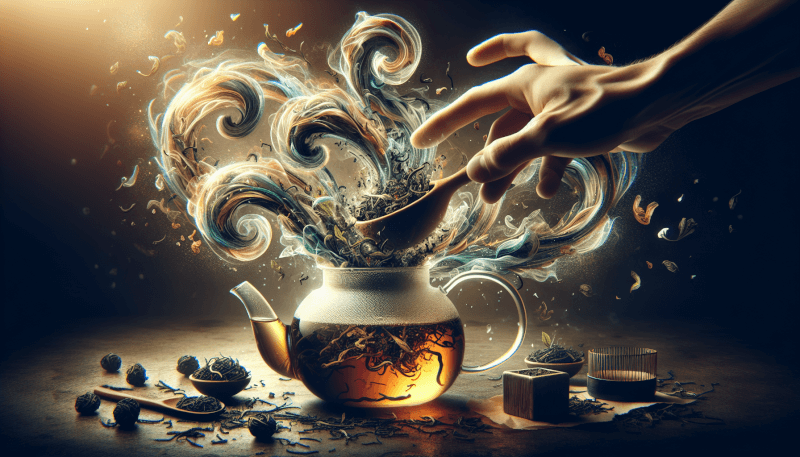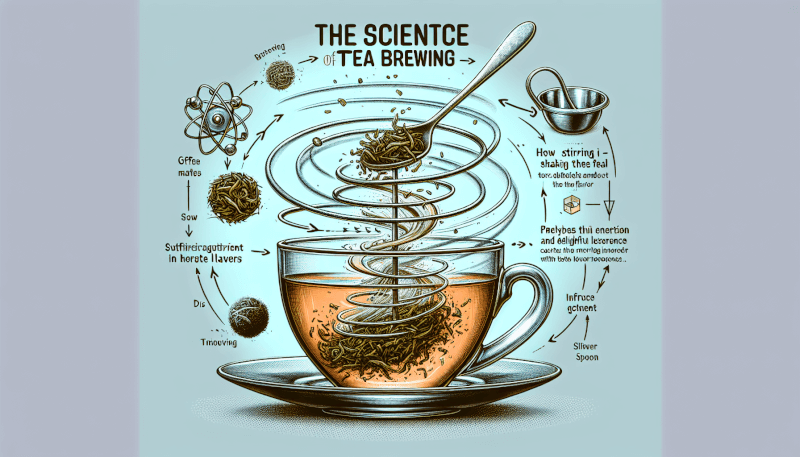Did you know that the simple act of stirring your cup of tea can significantly impact its flavor? It’s true! In fact, agitation plays a vital role in the brewing process, influencing the extraction of flavors and ensuring a well-balanced and aromatic cup. Whether you prefer a bold and robust brew or a delicate and nuanced infusion, understanding the role of agitation can help you unlock the perfect cup of tea every time. So grab your favorite tea leaves, get ready to stir, and let’s explore the fascinating world of agitation in tea brewing together.

Factors Affecting Tea Brewing
Temperature
One of the key factors that affects tea brewing is temperature. The temperature at which you brew your tea can have a significant impact on its flavor and aroma. Different teas require different temperature ranges to bring out their optimal taste. For example, black teas generally brew best at higher temperatures, around 200°F (93°C), while green and white teas are best brewed at lower temperatures, around 160-180°F (71-82°C). It is essential to pay attention to the temperature of the water when brewing your tea to achieve the desired flavor profile.
Time
The duration of steeping is another critical factor that influences the taste of your tea. Steeping it for too short or too long can result in under-extraction or over-extraction, respectively. The ideal steeping time depends on the type of tea you are brewing. Black teas typically require around 3-5 minutes of steeping, while green teas may need only 1-3 minutes. It’s important to follow the recommended steeping time provided for each particular tea to ensure you extract the desired flavors.
Tea-to-Water Ratio
The ratio of tea leaves to water is crucial in achieving the perfect brew. It determines the concentration of flavors in your cup of tea. Using too much tea can result in a strong, bitter taste, while using too little may lead to a weak, bland brew. The ideal tea-to-water ratio depends on personal preference and the type of tea you are brewing. As a general guideline, a teaspoon of loose tea leaves or a tea bag per 8 ounces of water is a good starting point. Adjusting the ratio to suit your taste is key in achieving the perfect cup of tea.
Agitation
Agitation, or the act of stirring or moving the tea leaves during brewing, is another factor that can greatly impact the flavor extraction process. Agitation plays a role in ensuring that the tea leaves are evenly distributed in the water, resulting in a more consistent and balanced flavor. It helps in releasing the flavor compounds from the tea leaves, allowing them to dissolve into the water. The technique and intensity of agitation vary depending on the tea type and personal preference.
Water Quality
The quality of the water you use for brewing your tea also affects the final flavor. Water with impurities or strong odors can alter the taste of your tea. Ideally, filtered or spring water should be used to brew tea, as they are free from contaminants and provide a clean base for extracting flavors. Avoid using distilled water, as it lacks the mineral content necessary to enhance the tea’s taste. Using fresh, clean water ensures that you get the purest and most enjoyable cup of tea.
Understanding Tea Agitation
Definition of Agitation
Tea agitation refers to the process of moving or stirring the tea leaves during brewing. It involves creating a gentle motion that helps in extracting the flavors from the tea leaves and distributing them evenly in the water. Agitation can be achieved through various techniques, such as stirring, swirling, or shaking the brewing vessel.
Importance of Agitation
Agitation is an essential step in the tea brewing process as it enhances the extraction of flavors. By agitating the tea leaves, you encourage the release of compounds that contribute to the taste and aroma of the tea. Agitation helps in making sure that all the tea leaves are fully immersed in the water, resulting in a more consistent and flavorful cup of tea. It also helps in preventing the tea leaves from settling at the bottom of the brewing vessel, ensuring a more balanced infusion.
Types of Agitation Techniques
There are several agitation techniques that can be employed when brewing tea. The choice of technique depends on personal preference and the type of tea being brewed. Some common agitation techniques include:
Stirring: This involves gently stirring the tea leaves in the water using a spoon or a tea utensil. Stirring helps in evenly distributing the leaves and extracting flavors.
Swirling: Swirling the brewing vessel in a circular motion creates a gentle agitation that allows the tea leaves to move around and release their flavors into the water.
Shaking: This technique involves gently shaking the brewing vessel to create a mild agitation. It is commonly used for certain types of teas, such as matcha or herbal teas.
Cycles of Agitation: In this technique, you alternate between moments of agitation and moments of stillness during the brewing process. This method can help in achieving a balanced extraction of flavors.
Experimenting with different agitation techniques can help you find the method that suits your taste preferences and brings out the best flavors in your tea.

Impact of Agitation on Flavor Extraction
Enhanced Extraction
Agitation plays a vital role in enhancing the extraction of flavors from tea leaves. When the tea leaves are agitated, it allows for greater contact between the leaves and the water, facilitating the dissolution of flavor compounds. This results in a more robust and flavorful cup of tea. Agitation ensures that the flavors are evenly distributed, providing a well-balanced taste experience.
Flavor Consistency
Agitation also helps in achieving flavor consistency throughout the brewing process. By continuously moving the tea leaves, you prevent the extraction of certain compounds from becoming too dominant, resulting in a more balanced flavor profile. Agitation ensures that all the tea leaves are equally exposed to the water, reducing the risk of over-extraction or under-extraction.
Over-Extraction
While agitation is crucial for flavor extraction, excessive or prolonged agitation can lead to over-extraction. Over-agitating the tea leaves can release too many bitter or astringent compounds, resulting in a harsh, unpleasant taste. It is important to find the balance between agitation and steeping time to prevent over-extraction and achieve the desired flavor profile.
Different Agitation Methods
Stirring
Stirring is one of the most common agitation methods used when brewing tea. By gently stirring the tea leaves in the water, you ensure that they are evenly distributed and promote the extraction of flavors. Use a spoon or a tea utensil to stir the tea leaves in a circular motion for optimal results.
Swirling
Swirling involves creating a circular motion with the brewing vessel, allowing the tea leaves to move around and interact with the water. This technique is particularly effective for teas that have larger leaves or need gentle agitation. Swirling helps in achieving a well-balanced infusion and brings out the desired flavors.
Shaking
Shaking the brewing vessel is a more vigorous agitation technique that can be used for certain types of teas, such as matcha or herbal teas. It involves gently shaking the vessel to create a mild agitation that helps in extracting the flavors from the tea leaves. However, it is important to avoid excessive shaking, as it can lead to over-extraction.
Cycles of Agitation
Cycles of agitation involve alternating between moments of agitation and moments of stillness during the brewing process. This technique allows for a more controlled extraction of flavors, as it gives the tea leaves time to infuse and settle before agitating them again. Cycles of agitation can help in achieving a well-rounded and balanced cup of tea.

Agitation Techniques for Different Tea Types
Black Tea
Black tea generally benefits from a more vigorous agitation technique. Stirring or swirling the tea leaves can help in releasing the robust flavors and aromas characteristic of black teas. However, be cautious not to over-agitate, as it can lead to a bitter taste.
Green Tea
Green tea is delicate and requires a gentler agitation technique to prevent bitter flavors. Swirling the tea leaves or using cycles of agitation can help in achieving a balanced infusion. Avoid vigorous stirring or shaking, as it can result in over-extraction.
White Tea
White tea, known for its delicate flavors, requires minimal agitation. Gentle stirring, followed by cycles of agitation, can help in releasing the subtle flavors without overpowering them. Avoid excessive shaking or swirling, as it can lead to astringency.
Oolong Tea
Oolong tea benefits from a combination of gentle agitation techniques. Stirring or swirling the leaves can help in extracting the complex flavors and aromas of oolong teas. Experiment with different agitation methods to find the optimal technique for each specific oolong tea.
Herbal Tea
Herbal teas often contain a blend of various ingredients, such as herbs, fruits, and flowers. Different herbal teas may require different agitation techniques depending on their ingredients. Gentle stirring or swirling is generally recommended to ensure that the flavors are evenly distributed.
Pu-erh Tea
Pu-erh tea, known for its aged and fermented character, benefits from a more vigorous agitation technique. Stirring or shaking the tea leaves can help in extracting the unique flavors and enhancing the overall experience. However, be mindful of the steeping time to prevent over-extraction.
Agitation and Tea Leaves Unfurling
Role of Agitation in Unfurling
Agitation plays a crucial role in the unfurling process of tea leaves. When the water is gently stirred or swirled, it encourages the tea leaves to open up and expand, revealing their full shape and size. Agitation helps in ensuring that all the leaves unfurl evenly, allowing for a more consistent infusion.
Impact on Flavor and Aroma
The unfurling of tea leaves through agitation also affects the flavor and aroma of tea. As the leaves open up, they expose more surface area to the water, enhancing the extraction of flavors. The unfurled leaves release their aromatic compounds, providing a more fragrant and enjoyable cup of tea. Agitation helps in maximizing the potential of the tea leaves, resulting in a more flavorful and aromatic brew.

Agitation Techniques for Tea Bags vs. Loose Leaf Tea
Tea Bags
Agitating tea bags requires a slightly different approach compared to loose leaf tea. Tea bags generally contain smaller, broken tea leaves that brew faster. Gentle stirring or swirling is usually sufficient to extract the flavors from tea bags. As tea bags have limited space for the leaves to unfurl, avoid vigorous agitation that may result in tea particles escaping from the bag.
Loose Leaf Tea
Loose leaf tea allows for more flexibility in agitation techniques. Stirring, swirling, or shaking can be employed to ensure that the leaves are evenly distributed and fully immersed. The larger size of loose leaf tea leaves enables them to unfurl more fully, enhancing extraction and providing a richer flavor experience.
Factors Influencing Agitation Effects
Leaf Quality
The quality of the tea leaves used greatly impacts the effects of agitation. High-quality, whole tea leaves tend to respond better to agitation, releasing their flavors more effectively. Broken or lower quality leaves may require gentler agitation techniques to prevent the extraction of undesirable flavors.
Water Temperature
The temperature of the water used during brewing also affects the agitation effects. Different temperatures can influence the rate at which flavors are extracted. For example, higher temperatures may require less agitation, as the heat itself contributes to the extraction process. Conversely, lower temperatures may benefit from increased agitation to enhance the extraction.
Brewing Vessel
The choice of brewing vessel can influence the agitation effects on tea. The shape and size of the vessel can impact the movement of the tea leaves during agitation. Wide and shallow vessels may require more stirring or swirling to ensure proper contact between the leaves and the water. Experimenting with different vessels can help determine the optimal agitation technique.
Agitation Duration
The duration of agitation also plays a role in the resulting flavors of the tea. Longer agitation periods can lead to a more intense extraction, which may be suitable for certain tea types or personal preferences. Conversely, shorter agitation durations may produce a milder cup of tea. Adjusting the agitation duration can help in fine-tuning the intensity and complexity of the flavors.

Brewing Tips for Agitating Tea
Proper Agitation Techniques
When agitating tea, it’s important to use gentle, fluid motions to avoid damaging the tea leaves. Whether you choose to stir, swirl, or shake, ensure that you are careful and consistent in your technique. Gentle agitation helps in achieving a balanced extraction of flavors without increasing the risk of over-extraction.
Recommended Agitation Times
The recommended agitation times vary depending on the type of tea being brewed. As a general guideline, most black teas benefit from a 10-20 second agitation period, while green and white teas may require shorter agitation times of 5-10 seconds. Oolong teas and herbal teas often benefit from agitation periods in between these ranges. Pay attention to the specific brewing instructions provided for each tea to achieve the best results.
Adjusting Agitation for Personal Preference
Agitation is highly subjective, and personal preference plays a significant role in determining the ideal agitation technique and duration. Experiment with different agitation methods and durations to find the combination that suits your taste preferences. Keep in mind that different teas may respond differently to agitation, so be open to adjusting your approach accordingly.
Conclusion
Agitation plays a vital role in the tea brewing process, impacting the extraction of flavors, aroma, and the overall taste experience. Understanding the factors that influence agitation, such as temperature, time, tea-to-water ratio, water quality, and leaf quality, allows you to optimize your brewing technique. By exploring different agitation methods for various tea types, you can unlock a world of flavors and enhance your tea brewing journey. Remember to experiment, pay attention to brewing recommendations, and adjust the agitation to suit your personal preferences to truly enjoy the art of brewing a perfect cup of tea.


